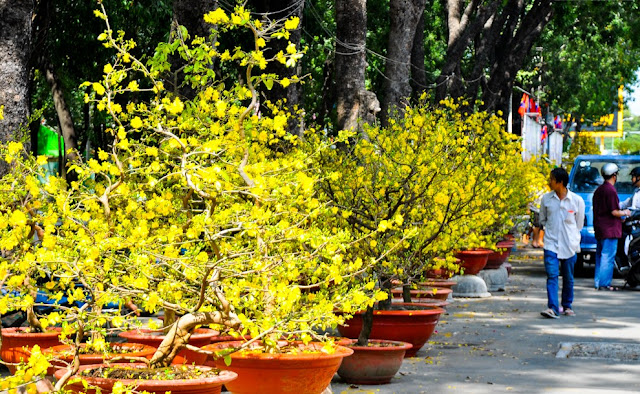Tet is a special occasion for many Vietnamese to decorate their homes with a vast choice of colorful and meaningful ornamental plants. Now let’s take a look at some of the most popular auspicious plants for Tet holiday and every day after.
1. Peach Blossom (Hoa Đào)
If you ever pay a visit to Hanoi during Lunar New Year, you will definitely agree that all over the place is covered with a cheerful color coming from these pink petals of peach blossoms. This kind of plant is known as an iconic flower for Northern Vietnamese when it comes to spring. It is believed that not only peach blossoms can chase away evil spirit, but they also bring in a fresh vitality to your home, which helps you stay healthy and peaceful. Not just that, if you are a businessman, then peach blossom cannot be forgotten due to its symbol as fertility and hope.
The best place to see the flowers is Nhat Tan (Nhật Tân) peach blossom garden located in Au Co Street, Hanoi.
2. Apricot Blossom (Hoa Mai)
Whilst peach blossom is the most popular Tet holiday’s auspicious flower in Northern Vietnam, apricot blossom can be seen as the spirit of Tết for Southern Vietnamese. Contrary to the pink that gets a great harmony with the freeze and coldness in the North, yellow petals from apricot blossoms represent for the torrid heat and humidity Southern Vietnamese have been enduring all year round. An image of five-petal apricot blossom symbolizes for “Five Blessings” in Oriental belief: longevity, wealth, peace, health and love of virtue, which mark the dearest hope of every Vietnamese in particular and Asian in general. Coincidentally, the word “Yellow” (vàng) in Vietnamese sounds identical to the word “Gold” or “Golden” (vàng). Consequently, apricot blossoms are decorated in most of the houses with a hope of good luck, happiness and, prosperity.
3. White daffodil (Hoa Thủy Tiên Trắng)
Apart from peach blossoms, white daffodils find favor with lots of Hanoi citizens in terms of their multi-function and symbolic meaning. Unlike any other holiday ornamental plants, every single part of a daffodil can be exerted: flowers, fragrance, leaves and tuberous roots. Water must be replaced in every morning in order that roots can be kept clean and not turn smeared. According to Oriental or Asian outlook, this plant bears a good meaning. Word-of-mouth has it that, if white daffodils bloom right in the moment of New Year’s Eve in one’s house, the whole family will end up with happiness, good luck, and prosperity. Bưởi market, a local village fair in Hà Nội, is where people always come to find white daffodils by the time of Tết. Besides using them as ornamental plants, trimming and arranging the daffodil flowers can be an absolutely great art.
4. Kumquat tree (Cây Quất)
Vietnamese believe that owning a luxuriant kumquat tree in the middle of their home brings good health and good luck to their business. It is a symbol for a greatly prosperous year ahead. Hence, there is no doubt to see kumquat trees displayed for sale at every single corner of the street in many flower markets all over Vietnam. Located next to China, Vietnam has adopted a lot of Chinese cultures, customs, and beliefs. Feng Shui is not an exception. As a result, planting and trimming a kumquat tree must be conformed to some decorating rules, in order to turn it into a perfect shape. An ideal sample of kumquat tree will have big shiny dark green leaves, and all the fruits must bear a similarity in size and give a juicy look. When people are running a business, they should place a kumquat tree at the front door of their offices or stores so that it can bring wealth and clear sight. That is the reason why man must serve good experience in life as well as Feng Shui application once it comes to purchase and display kumquat trees.
5. Fig (Sung)
Rather than being seen as a usual tree in a back garden of someone’s house during Lunar New Year, figs are usually displayed as one of the main fruits on a five-fruit tray, especially in Southern Vietnam. A typical five –fruit tray will include custard-apples, coconuts, papayas, mangoes, and figs, which can be literally translated as “wishing for a well-off life” in Vietnamese when combined in sound. By itself, “fig” in Vietnamese sounds identical to “comfortable”, “well-off” or “prosperous”. Apparently, we can totally understand why figs are favored by Vietnamese during Lunar New Year.
See more: Where to travel in Vietnam during Tet?
Source: mazevietnam






No comments:
Post a Comment